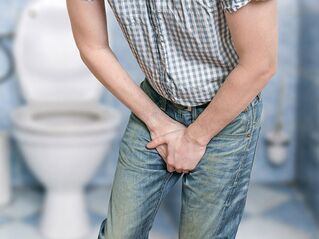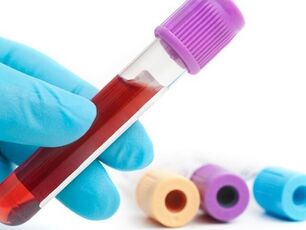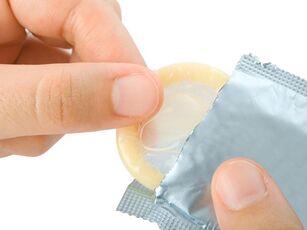Prostatitis is a purely male pathology of the urinary and reproductive systems. The disease can be acute or chronic, manifesting itself differently in each patient. Today it is a common disease of the genitourinary system. At this time, the disease is very young and is already seen in men over 25 years. In this article we will consider the question: how does prostatitis manifest itself and its treatment.

Required information
The nature of prostate dysfunction depends on a certain stage of sexual development in men:
- Prostate damage is possible in underage men. However, such a disease is not considered a separate disease because the pancreas does not develop;
- Men who have a hard sex life are more prone to prostatitis in the form of an acute inflammatory process;
- In adult men, prostate disease manifests itself in the form of one of three diseases: benign and malignant tumors, chronic prostatitis.
People who have had any reproductive surgery have no prostate function.
The prostate is an extra gland of the reproductive system in the strong hemisphere. Located at the junction of the urinary tract and the discharge tunnel. Studies on the importance of the prostate gland in adolescent men have disrupted research. In adults, the prostate is responsible for:
- The formation of a secretion that makes seminal fluid less viscous and allows sperm to survive on the way to the egg;
- Formation of prostaglandins in the body. It is a component responsible for the increased blood flow in the genitals before an erection occurs. It also increases the production of the hormone testosterone;
- is responsible for the rate of sperm release during ejaculation and also participates in the formation of the last sexual moment associated with the peak of intimate pleasure; With the help of reflexes
- does not allow urine to penetrate the semen during intercourse.
The prostate gland is a poorly protected organ for pathogenic microbes. It directly depends on the pathological conditions of the pelvic organs. A large flow of blood and lymph through the vessels of the damaged prostate causes the phenomenon of stagnation and edema, thereby aggravating the inflammation. The gland contains a large number of nerve fibers, so it manifests itself in pathological pain.

Prostatitis is an inflammatory lesion of the prostate gland. The most common cause of this disease is pelvic infections. However, the trapped infection itself cannot cause inflammation; this requires the presence of predisposing factors. This category includes:
- measured lifestyle (sedentary people are at risk);
- regular stool retention;
- multiple hypothermia;
- excessive active intimacy and prolonged abstinence;
The prostate is a small organ, about 20-25 grams. However, the secretion of the gland has the ability to destroy microbes, so inflammation in the prostate occurs during stagnation, and then the secretion loses its bactericidal properties.
manifestations of prostatitis
There are two stages of the disease:
The acute form is characterized by the strongest inflammation in the prostate gland. The patient has a fever of up to 39 degrees, pain in the groin area and during the excretion of feces and urine by the body. These are the first characteristic signs of prostatitis.
In a chronic course, these symptoms are corrected, so many men do not pay attention to the characteristic manifestations of the disease. The patient may experience fever up to 37 degrees, painful sensations during deurination and defecation. However, the main symptom of chronic prostatitis is the discharge of small amounts of mucous or purulent substances from the urethra.
Predisposing factors
There are 6 first symptoms of prostatitis - a failure in the process of deurination due to a complex urination of the bladder when the urethra is compressed by an enlarged prostate gland (dysuria syndrome):
- dripping urine;
- painful feelings;
- urine flow without pressure and not more than 20 cm;
- stop the jet;
- frequent deurination at night;
- feeling of incomplete emptying of the bladder.
Important! It is forbidden to diagnose prostatitis when these symptoms are detected without a thorough examination. The disease has a very complex origin and development process involving various mechanisms.
Do not treat a disease based on a single clinical manifestation. You should contact a specialist immediately to determine the correct diagnosis and therapeutic measures. Diagnosis and therapy are determined taking into account the organs and systems affected by the disease. In some cases, you may need to consult other professionals.
Symptoms
Prostatitis can manifest itself as an acute and chronic form of the inflammatory process. The acute course is characterized by inflammation of the mucous membranes, follicles and parenchyma, but should not be confused with the symptoms of prostate adenoma. And chronic - manifests itself with concomitant diseases.
Symptoms of prostatitis in men as a result of clinical and functional examinations:
- Frequent urination
A normal person may want to take deurine up to 12 times a day, usually 5 times a day. In a healthy patient, the volume of urine is 1 to 2 liters per day. In a healthy person, the desire for deurination occurs when the bladder is filled with a volume of 120-170 ml. Accumulation of more than 350 ml of urine creates the strongest desire for urination.

In the process of inflammation, the walls of the bladder are systematically irritated and deurinated:
- is not uncommon when urine volume is normal;
- in small amounts: the products of the inflammatory process irritate the receptors of the bladder, and false desires for deurination, a feeling of full bladder, a feeling of fullness after emptying remain;
- painful due to narrowing of the urethra;
- Difficulty due to compression of the urethra by the gland, sometimes manifested by the inability to empty the bladder in a compressed state;
- often at night;
- temperature.
Typically, the temperature rises from 37 to 38 degrees. In the early stages of sepsis with purulent inflammation of the pancreas, the temperature rises above 39 degrees. In the final stage of septic shock, on the contrary, the temperature drops to 35 degrees. Low temperatures are life-threatening due to platelet coagulation disorders. In prostatitis, a complication of sepsis, the result is unpleasant.
- Blood in the urine
This is very rare, but a dangerous sign of the disease. It is almost impossible to stop the constant bleeding. There are several reasons for the development of hematuria:
- with perforation of the vessel into the urethra;
- trauma during research;
- malignant hyperplasia;
- pain.
Inflammation of the prostate with a related complication is accompanied by constant pain. In rare cases, it may be intermediate. Often the pain is dull or painful in nature and manifests itself in the perineum and anus.
Laboratory Methods
Designed to clarify the stage of the disease:
- Blood test. With the prostate, an increased content of leukocytes, an increase in the rate of erythrocyte sedimentation, and a change in the leukocyte formula toward knife cells are detected;
- urinalysis. Determines the purulent content of urine and the presence of bacteria. A study is used on 3 jars: 3 servings of urine are taken at the beginning, middle and end of deurination. Numerous studies of urine over a period of several days show changes in the bacterial flora;
- Bacteriological blood culture. It is prescribed for blood poisoning that develops with fluctuations of 3-5 degrees daily.

Instrumental research
- Ultrasound through the rectum. Clarifying the diagnosis is the most informative method. There are contraindications to this work.
- X-ray method. Before the examination, a contrast agent is injected into the bladder.
- For limited indications, the removal of a piece of tissue for microscopic examination is used.
Causes of prostatitis
Experts identify several classifications of why a man can have prostatitis:
- aggravation of any disease symptom that previously affected a person or the negative impact of common gynecological diseases;
- urethral reflex. Prostate failure is fraught with the inability to stop the return of urine. When this fluid reaches the genital canals, it is called the urethral reflex. Later, a glandular bacterial seed is formed. This disease is the result of inflammation in the urethra or improper placement of the catheter. There is also an enlargement of the lumen of the urethral canal;
- An unusual intimate lifestyle. If a man has a significant increase or decrease in the number of sexual intercourse, it can contribute to the development of prostatitis. Continuous delays in ejaculation are also a concern;
- Stopper of venous blood in the genitals in the pelvic region. This happens in the absence of a sufficient number of active movements, sports;
- Hormonal diseases caused by low production of hormones in the gonads. There is a common concern of skeletal and smooth muscles and other diseases due to this pathology.

types of prostatitis
There are two divisions of this disease: bacterial and non-bacterial.
The first type of disease is characterized by the presence of pathogenic microbes that enter the body from the external environment. Staphylococci, streptococci, Escherichia coli and others belong to the category of harmful microorganisms. In addition, this classification of prostatitis includes cases in which the disease is caused by a sexually transmitted disease.
There are several subdivisions for the second non-bacterial species:
- Congestive prostatitis. In this case, pancreatitis causes blockage in the pelvic region. This result is usually caused by incomplete ejaculation, excessive intimacy, prolonged abstinence, incomplete sexual intercourse.
- Sclerotic prostatitis. It is characterized by a decrease in the size and function of the prostate. There is a thickening of the tissue membrane due to the death of prostate cells and their transformation into hard connective tissue. Causes of this type include frequent defecation disorders in the form of difficult, slow bowel movements, taking certain medications, and numerous infections. This type of prostatitis is incurable.
- Significant prostatitis. With this type of inflammation, the presence of stones in the gland occurs. When they reach a large size, they cause severe pain in the urethra. Therapy consists of surgical or therapeutic removal of stones.
- Prostatodinia. It is characterized by persistent pain in the pelvic region, the causes of which have not been studied. It is likely to be caused by a backflow of secretions, a disease of the bladder neck, damage to the muscle tissue between the anus and genitals, and a psychological factor.
- Atypical prostatitis. The patient may complain of pain in the lower extremities, back and sacrum, which are not typical forms of prostatitis. The outcome of therapy is directly related to the course of the disease, the presence of complications and the severity of the inflammatory process.

If treatment is started at the wrong time or if there is a recurrence of prostatitis, the inflammation becomes severe and is fraught with serious complications: decreased potency, inability to conceive, depression, severe pain, prostate adenoma in men.
Complications
Everything will directly depend on age, immunity, bad habits and timeliness of treatment. Thus, the consequences will be very severe in elderly people with low immunity, who are complicated by excessive consumption of alcoholic beverages.
Potential activity. The damaged gland reduces the production of hormones responsible for the onset of erection. Complications include incomplete sensation during intercourse, poor ejaculation, signs of prostate adenoma in men, and impotence.
Influence on a child's conception. An inflamed prostate greatly reduces the production of normal secretions needed for sperm activity in the female reproductive organs for fertilization. The secret of entering a girl's birth canal during intimacy is exposed to the rejection of immunity, which leads to the impossibility of fertilization of the egg.
Other complications. With the exacerbation of prostatitis, the risk of accumulation of pus in the glandular tissues increases. Pain increases with prostatitis. When a secondary infection is added, the epithelium melts, then a capsule forms near the inflammation. In addition, the results include acute forms of urinary retention, urolithiasis, the appearance of prostate adenoma in men, and others.
Intimacy with inflammation
It has already been proven that the main causes of prostatitis are increased arousal or lack of sexual intercourse with excessive sexual activity. Normal soon regular discharge has a beneficial effect in the early stages of prostatitis. Proximity is temporarily prohibited in some procedures and stages of the disease. You can find more information by consulting a specialist.
Important! You can show love during the treatment of prostatitis, but you can only respect safety and gentleness in relationships, unless otherwise prescribed by a doctor.
Prostatitis is a purely male disease. However, inflammation of the pancreas poses a health risk to the partner. It is a danger to the conception and birth of the unborn child. A healthy lifestyle and reliable contraception are an effective way to protect your partners from complications.

Prostatitis Treatment
Further development of the disease can be completely restored and stopped only by timely consultation with a specialist. In this case, you will get a positive result. When irreversible changes occur, it is impossible to completely get rid of the disease. As a rule, recurrent inflammation occurs with the transition to a chronic type.
In addition to medication, an important point is whether the patient is ready to change their lifestyle (for example, irregular relationships or a sedentary lifestyle). If the patient does not want to change his usual lifestyle, he will soon feel the disease again. Due to the fact that the patient does not want to change these negative factors and prostatitis can not be cured.
Treatment options will be determined by a specialist after a time examination and determination of the cause. The main drug used in treatment is antibiotics. It is recommended to take vitamins, physiotherapy, analgesics and anti-inflammatory drugs. Exacerbation of prostatitis takes longer to treat.
Diet
With a proper diet and the use of certain foods, you can achieve the following:
- reduces pain;
- Improving blood and lymph flow in the prostate vessels;
- boost the immune system;
- normalization of intestinal function;
- Decreased night urine production.
The following foods should be excluded from the diet:
- Coffee and spicy foods - increase blood flow to the prostate, increase pain.
- Fats, fatty meats, eggs, flour products - increase the formation of cholesterol plaques on the walls of blood vessels, reduce blood flow.
- Alcohol - lowers the body's immune system.
- Coarse fiber and salty foods - disrupt the wavy contractions of the intestinal wall.
- Excessive fluid intake (especially in the evening) - increases the amount of fluid in the body, which leads to swelling.
Recommended foods: fresh vegetable salads with olive oil, fruits, boiled lean meats, vegetables, juices and nuts.

Prevention
Recommended:
- wide-step walking (physiological walking);
- rational nutrition;
- healthy lifestyle;
- use of male contraceptives;
- mild intimacy and more.
Result
You don't have to wait for any disease to appear, but you should see a doctor once a year for prevention. Treatment of secondary inflammation of the prostate is very difficult and takes longer, and at the same time is fraught with its own complications.
In this article, we learned how inflammation of the prostate gland manifests itself, what is the pain in prostatitis, and how to treat this disease.
























